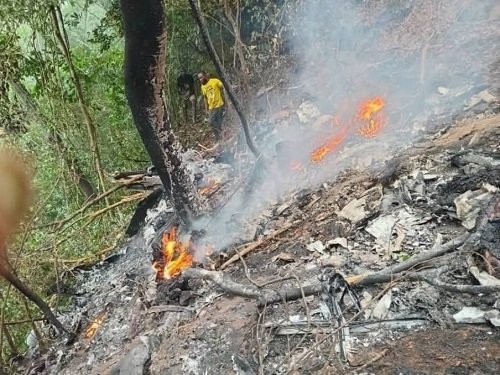The investigation into the military helicopter crash that killed eight people on August 6, 2025, this year has concluded that the accident was caused by sudden bad weather and a powerful downdraft that forced the aircraft to lose altitude unexpectedly.
According to Captain Paul Fodjour, Head of Investigations at the Aircraft Accident and Incident Investigation and Prevention Bureau (AIB-Ghana), the helicopter encountered severe weather conditions shortly before the crash.

He made this known on Tuesday when he presented the final report of the probe team to the public in Accra.
The helicopter, identified as Z-9EH with tail number GHF 631, was flying from Accra to Obuasi on August 6, 2025, when it crashed in the Ashanti Region.
All three crew members and five passengers on board lost their lives.
Following the tragedy, President John Dramani Mahama directed that a full investigation be conducted to determine the cause of the accident and recommend measures to prevent future occurrences.
The investigation team, led by COP Abdul Razak Osman, National Security Coordinator, included experts from the Ghana Armed Forces, AIB-Ghana, the National Intelligence Bureau, and the U.S. Air Force.
Captain Fodjour explained that the aircraft was airworthy and had passed all necessary safety checks before takeoff.
However, it lacked modern safety systems such as a terrain awareness warning system, autopilot, and advanced navigation features, which could have helped the crew detect and avoid danger.
He revealed that the flight had been delayed earlier due to poor weather, but conditions worsened midair.
“Visibility deteriorated rapidly due to mist and low clouds. The crew tried to climb to clear rising terrain but suddenly lost altitude and crashed about six and a half miles from Obuasi” he said.
According to him, the investigation determined that a downdraft, a sudden downward movement of air caused by changing weather conditions over hilly terrain was the main factor that led to the crash.
“The accident was an unfortunate and sudden weather-related event. The crew were experienced and medically fit, and the aircraft was mechanically sound,” Captain Fodjour stated.
He commended the emergency response teams for their swift reaction.
“Despite the rough terrain, rain, and slippery conditions, rescue teams reached the crash site within two hours. Their effort was remarkable,” he said.
The final report made several safety recommendations aimed at preventing similar accidents in the future.
These include the modernisation of the Ghana Air Force fleet with aircraft equipped with terrain warning and modern navigation systems, the installation of cockpit voice and flight data recorders with audiovisual capability, and investment in flight simulators for pilot training.
The report called for the contracting of certified aviation weather service providers, the establishment of flight data monitoring and real-time tracking systems, and the expansion of navigational aids across the country, especially in remote areas.
Captain Fodjour said implementing these recommendations would help strengthen Ghana’s aviation safety system.
He expressed appreciation to the National Security Secretariat, U.S. and Chinese partners, and the AIB-Ghana team for their technical and logistical support throughout the investigation.
“Our goal is to turn this tragic event into lessons that will make aviation in Ghana safer,” Captain Fodjour said.
By: Jacob Aggrey
The post Poor weather and downdraft caused military Helicopter crash – Investigation Report appeared first on Ghanaian Times.
Discover more from Ghana Scoop
Subscribe to get the latest posts sent to your email.


